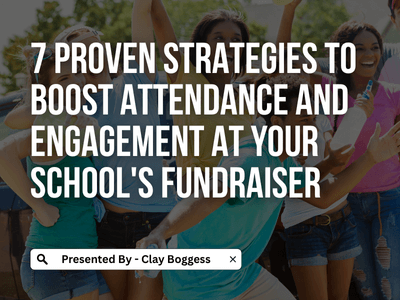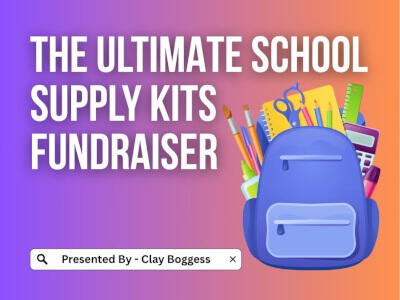
How to raise more money with fewer fundraisers.
With ever-shrinking district budgets, money continues to become scarcer. Many educators don't have enough funds to pay for essentials, let alone extraneous things like new playground equipment, educational field trips, and a new marquee.
In addition to the tax dollars that are supposed to fund our schools, should parents have to raise money for this stuff, and are students being used as pawns to sell in exchange for prizes?
Many are bothered by this. But we don't have much of a choice. If we want what our tax dollars can't provide, the money has to come from other sources. So where's the compromise?
One solution is to implement elementary school fundraising ideas that work so we can raise more money while making fewer sales. No one wants to spend more time than they have on ongoing campaigns.
This sounds way too obvious. Of course, everyone would like to be able to have fewer fundraisers. But schools don't seem to be taking the necessary steps. Too many groups are unfortunately doing little more than handing out their sales materials and asking their students and parents to help.
It's as if the items in the brochure magically sell themselves, and the money will roll in. School sales are like walking zombies. Little passion or energy is being put in. Students and their parents are only selling because they're being asked to. They don't understand why.
We provide many tools that, if utilized, can help bring in more money. But emails go unread. Why? People don't have the time. It's a matter of priority. We get it. Fundraising doesn't usually make the 'top 10' priority list.
But unfortunately, you reap what you do. So what ends up happening? The first sale doesn't go that well, so let's have another one, and so on.
Two goals are at the top of every elementary school sponsor's list when planning a sales campaign.
- Reach their fundraising goals.
- Make the entire process as simple and easy as possible.
These are the goals that everyone strives for, but some effort and planning still need to be put in before the sale. It's too good to be true to roll out the ball and expect your team to play well.
Proper planning and execution of the following three elementary school fundraising ideas will help make your sale more successful. And at the end of the day, you won't have to work as hard because you'll be able to accomplish your objectives with fewer campaigns.
1. Plan a Proper Elementary School Fundraiser Kickoff
The fundraiser kickoff meeting is probably the most essential part of your sale. It will help set the tone for your ultimate success. If executed properly, your students will come away excited and eager to share their packets with their parents and start selling. But just as important, they'll understand what they need to do and why they're doing it. Winning prizes is essential, but it's just one part of your presentation.
Setting the right tone with an exciting atmosphere is an excellent place to start. Begin by having your students, teachers, and staff together for one large assembly. Have upbeat, radio-edited music in the background before your students walk in. Why is this important? To help foster a higher level of energy and unity.
It's also essential to plan your message ahead of time. The most important part of your presentation is communicating your purpose. What do you want everyone to know about your cause, and how will it benefit you?
Next, your students will need to know how the sale will work. Among other things, here are three questions that you'll have to answer:
- How many items do your students need to sell?
- Who do they need to speak with about the sale?
- When is the money going to be collected?
For more information about how to leverage your sale, see elementary school fundraising ideas that work.
2. Determine Your Elementary School Fundraising Goal
You can't just tell your students to 'do their best'. What does this mean? Of course, everyone hopes for that. More specific information needs to be communicated. Students need to know what's expected of them. How many items must they sell to help the school reach its fundraising goal?
To do this, you'll need to do some calculations beforehand. You'll need to know how much money you need to raise overall and how much each student needs to sell individually. Here's the basic math:
Total $ raised = the # of students x $ raised by each student
Simple enough, but how do we get there?
For simplicity's sake, we assume that everyone reaches their goal; however, in the real world, some will sell, and others won't. The best scenario is to involve as many students as possible and have many additional sellers exceed their 'fair share' goal. The 'overachievers' will make up for the non-sellers.
Let's look at an example. Let's say you have 500 students and need to raise $12,000. A good rough estimate is to use $15 for the average retail price of your brochure items. Therefore, if you make 40% profit, you'll average $6.00 profit off each item sold ($15 x 40% = $6.00):
- $12,000 ÷ 500 students = $24 profit per student
- $24 ÷ 6 = 4 items (Each student's fair share goal)
We've made this step relatively simple with our 'Calculate Your Profit' tool on our brochure fundraiser pages. You can enter your group size and a reasonable sales goal for each student, and your profit is automatically calculated. You can adjust the goal numbers on the calculator until you arrive at your desired profit amount.
3. Track Elementary School Fundraiser Progress
Most schools don't do this. However, those that do almost always end up raising more money. Monitoring your progress is essential because it's a great way to remind your students to keep selling.
Once your kickoff is complete, your work has just started. Tracking your sale also provides a gauge that allows you to make any needed adjustments as your sale progresses. You already told your students how much they needed to sell at the kickoff meeting; however, how can you know they are selling anything?
First, don't just do 'remember to sell' announcements over the intercom. It's essential to check in with them consistently and actively. This helps you gauge the progress of the sale and holds your students accountable to continue to work towards their goals. One way that's been proven effective for many of our elementary schools is to employ periodic prize drawings.
Drawings provide a practical, hands-on approach to monitoring real-time sales while making the entire process fun and engaging for your students.
See our additional incentive ideas that you can incorporate into your drawings.
Unfortunately, there's no easy way to a successful elementary school fundraiser. To make things easier, focus on making each sale more productive. Ultimately, you'll save time with fewer sales while raising more money.
Author Bio
Clay Boggess has been designing fundraising programs for schools and various nonprofit organizations throughout the US since 1999. He’s helped administrators, teachers, and outside support entities such as PTAs and PTOs raise millions of dollars. Clay is an owner and partner at Big Fundraising Ideas.



